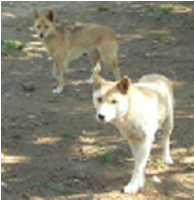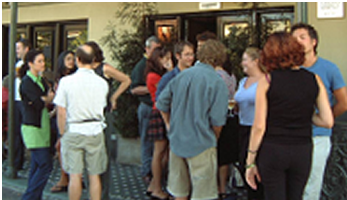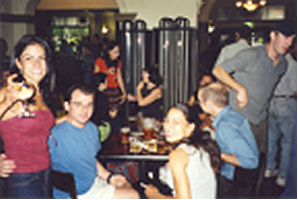|

Alan
Wilton, University of NSW.
My day in Science on 15th April was a typical day spent organising
and communicating with students and colleagues. One advantage
of being an academic is that I have a large degree of independence
and since early mornings are not my most productive time I rushed
into the campus from my beachside apartment which is a 5 minute
drive (or 30 min walk) for a meeting with one of my PhD students
at 10.

We are publishing a paper on our discovery of the gene that
causes a genetic disease which is common in Border collies.
It is a nerve degenerative disease called NCL that results in
slow decline of young dogs and was a great thrill to finally
identify the gene after 10 years of searching. The reviewers
of the manuscript wanted us to make modifications that they
think willl improve it before they will accept it in their journal.
We had to discuss the progress in modifying tables and figures
and changes to the wording to make it clearer etc.

The student went to make the amendments about 11 and I talked
to one of my Honours students who is just beginning a year of
research in the lab. He is working on a different dog disease,
one that results in susceptibility to infections from lack of
white cells in the blood. The experiments that were working
so well a few weeks ago were now not working. It took a bit
of detective work and two heads going over all the procedures
for us to work out that there had been a simple confusion between
two methods. He was using the conditions for sequencing instead
of PCR which are different. He had been doing both successfully
but got the two confused. I had the satisfaction of a problem
solved and a promise of progress on the research.
Next
I had to check that the part-time research assistant that I
have employed to help us to detect the NCL defect in 600 Border
collie samples knew what to do next. We are trying to optimise
the experimental conditions to get the clearest results as people
will use this information to determine whether to breed from
a dog or not.

The student researching the demise of the dingo was away at
a martial arts competition and the endocrinologist in the lab
working on genetics of gestational diabetes was working at a
clinic so I could check my emails First I had to contact a vet
in Japan who had a suspected cases of NCL coming in and they
wanted to find out how to go about getting the DNA test that
we have developed done. We are just setting up this testing
in the lab and the information is not yet readily available
on the web. Besides sending samples from Japan requires knowledge
of the right storage and handling and information on the Import
Permits that are required to bring in biological samples.
Next
I tried to contact a colleague and friend in New Zealand where
I will be attending an international conference on Molecular
Biology and Evolution in June. It will be good to catch up with
old friends at the meeting and visit with my colleague’s
family. Are there enough funds in the research grants to cover
this? It is a long time since I did the accounts so I don’t
know. A quick check takes 20 min and it shows I will have to
pay for it myself. I sent a few personal emails to arrange a
weekend away with friends camping and a few administrative ones.
The dog breeders want to know when testing will be available.
A friend wants me to find researchers in water quality testing
to help check the water reclaiming system he has installed in
his backyard so that he can reuse all the household waste water
from washing and sewerage. It has to be shown to be free of
bacteria and viruses before it can be used. He has gone to great
expense because of his ecological ideals rather than be a user
like the rest of us.

By 1:30 I managed to get time to a quick bit of electronic bill
paying and write a letter objecting to a parking fine then grab
a quick bit of breakfast/lunch to eat back in the office. It
is a shame we spend so much of our day in the office when Sydney
has such glorious days all year round. Shortly after I get back
I get an unexpected call from a reporter who had seen an interview
I did on the imminent extinction of the dingo in Australia.
The ABC program Catalyst had a segment about the plight of the
dingo and wanted to know about the DNA testing we are doing
on wild dogs to determine if there are any purebred dingoes
left out there. The reporter needed to check some facts and
find further information which I sent by email.
 I
needed to make sure that the notes and data for next week’s
computer practical were in order and I had to put the notes
from Wednesday’s lecture on the web, then I went back
to the revisions for the manuscript. I had realised that the
data looks a little odd in the figure. It should not go up at
the ends it should go down. Why does it do that? We had used
the order of the genes for a genetic map. Now the complete genome
of the dog was available and I can see the location of the genes
on the the chromosome. This data is more accurate and gives
a different gene order. The student will have to reanalyse the
data with the new gene order and hopefully it will remove the
anomalies. I
needed to make sure that the notes and data for next week’s
computer practical were in order and I had to put the notes
from Wednesday’s lecture on the web, then I went back
to the revisions for the manuscript. I had realised that the
data looks a little odd in the figure. It should not go up at
the ends it should go down. Why does it do that? We had used
the order of the genes for a genetic map. Now the complete genome
of the dog was available and I can see the location of the genes
on the the chromosome. This data is more accurate and gives
a different gene order. The student will have to reanalyse the
data with the new gene order and hopefully it will remove the
anomalies.
5 pm and the students from the School were putting on a Happy
Hour as they do every 2nd Friday. So after a few drinks and
discussion with colleagues it was back to work by 6. I am on
one of the Human Ethics Committees of the University and this
month’s pile of applications had arrived for assessing.
However, we needed to modify the text of the paper as requested
by the reviewer and to reflect our new figures and tables so
the applications will have to wait. I had to email a collaborator
in Norway about the wording referring to some of his work. Meanwhile
I am firing emails back and forth to the dog breeders about
who we can get to do the testing for NCL in other countries.
Some companies have shown a keen interest.


At
9:52 pm I finish my drafting of the changes to the paper and
send them off to my student to look over before our Monday morning
meeting. Now it is off to the local pub to join the students
who are having the usual quiet end of week drink. They have
a bit of a head start on me.
This
is not what I envisaged I would be doing when I left school.
I had a flare for science but that was chemistry not biology.
I toyed with the idea of being a pharmacist, an analytical chemist
or even a dentist. It was not until the last year of university
that I discovered genetics. It was a good choice to do research
and a PhD because since that time there has been a revolution
in the field. Viva the revolution.
|